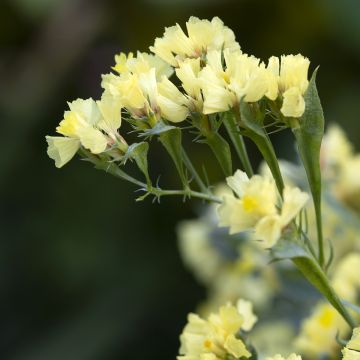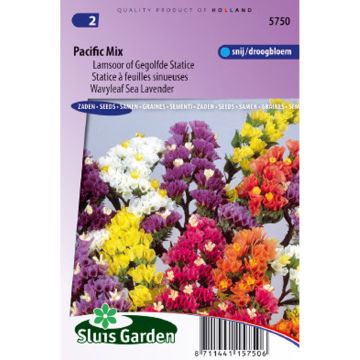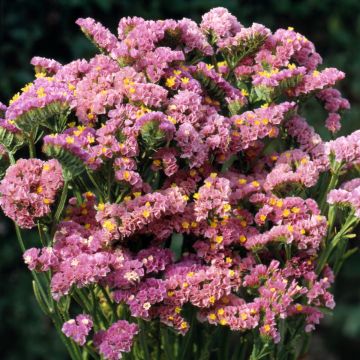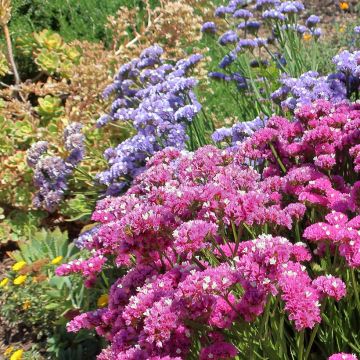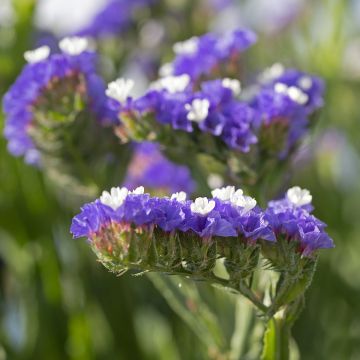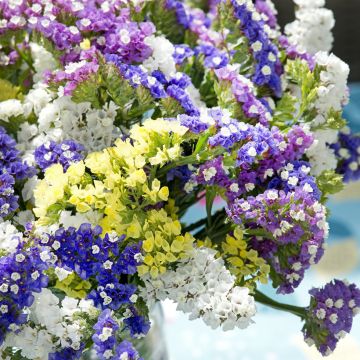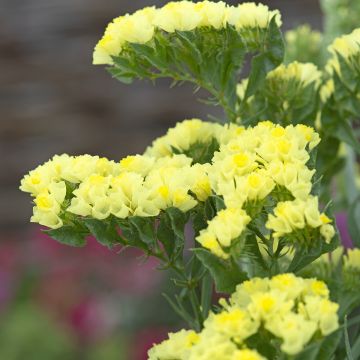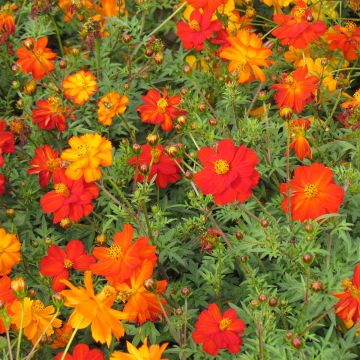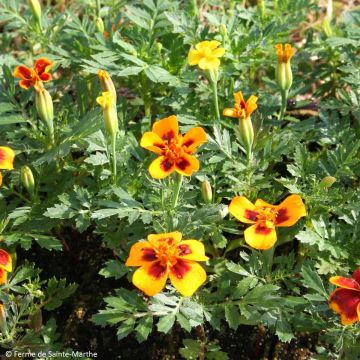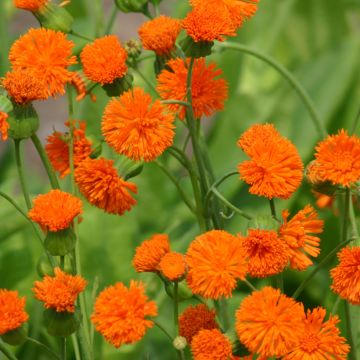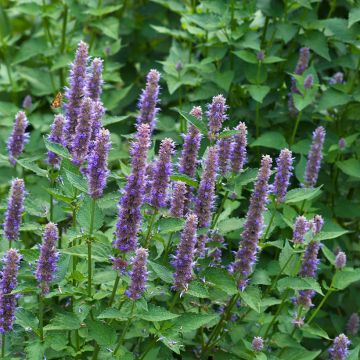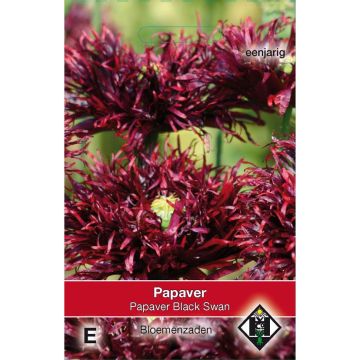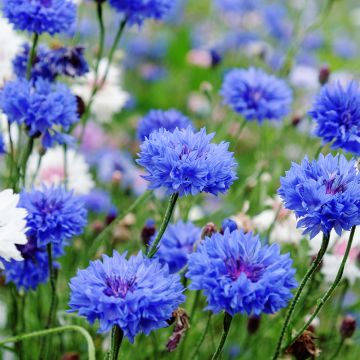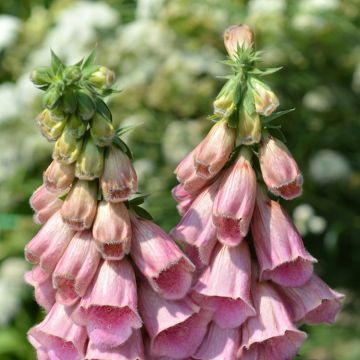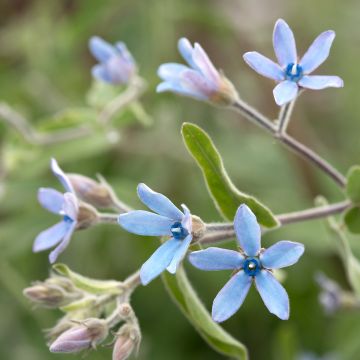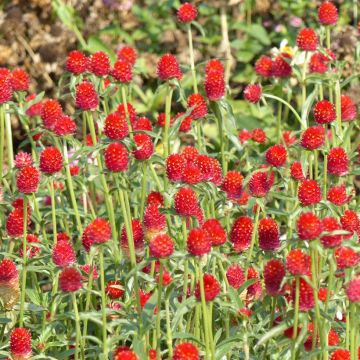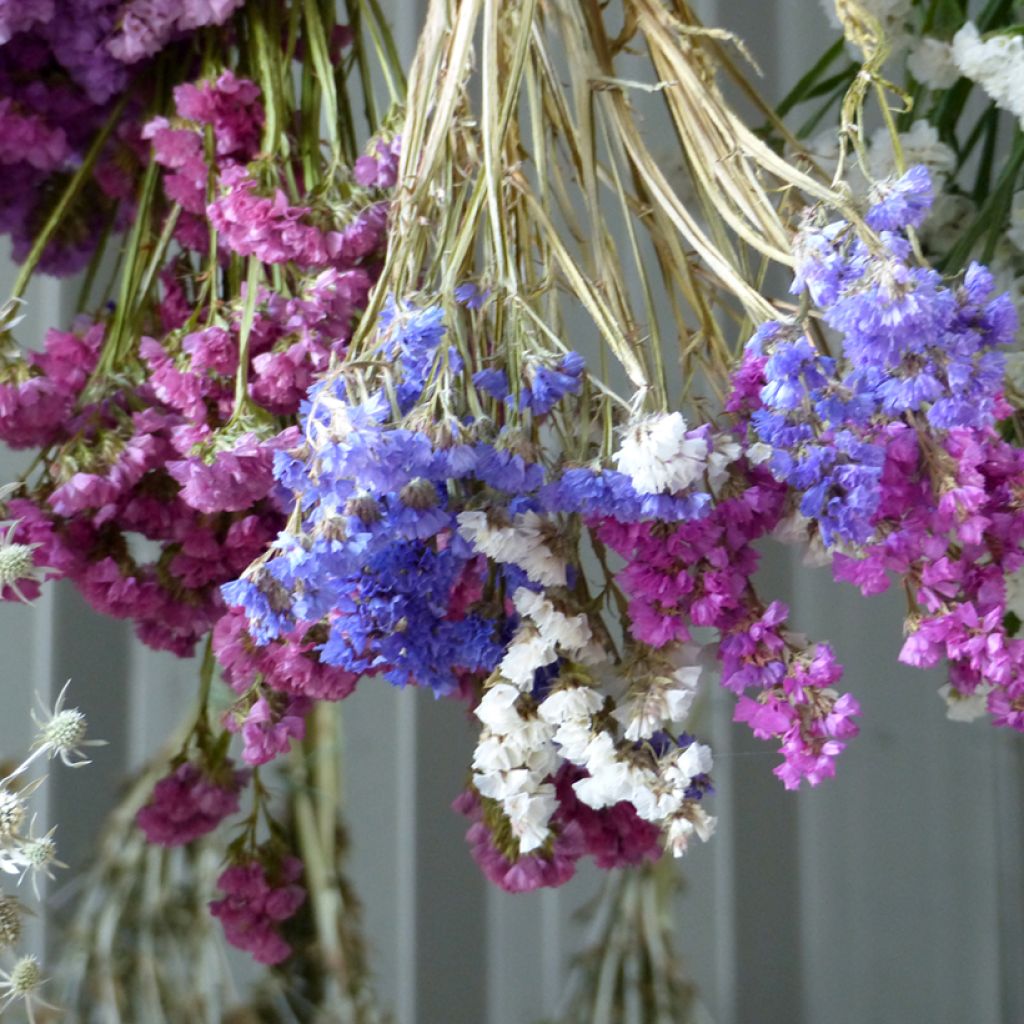

Limonium sinuatum Forever Art Shades seeds - Statice
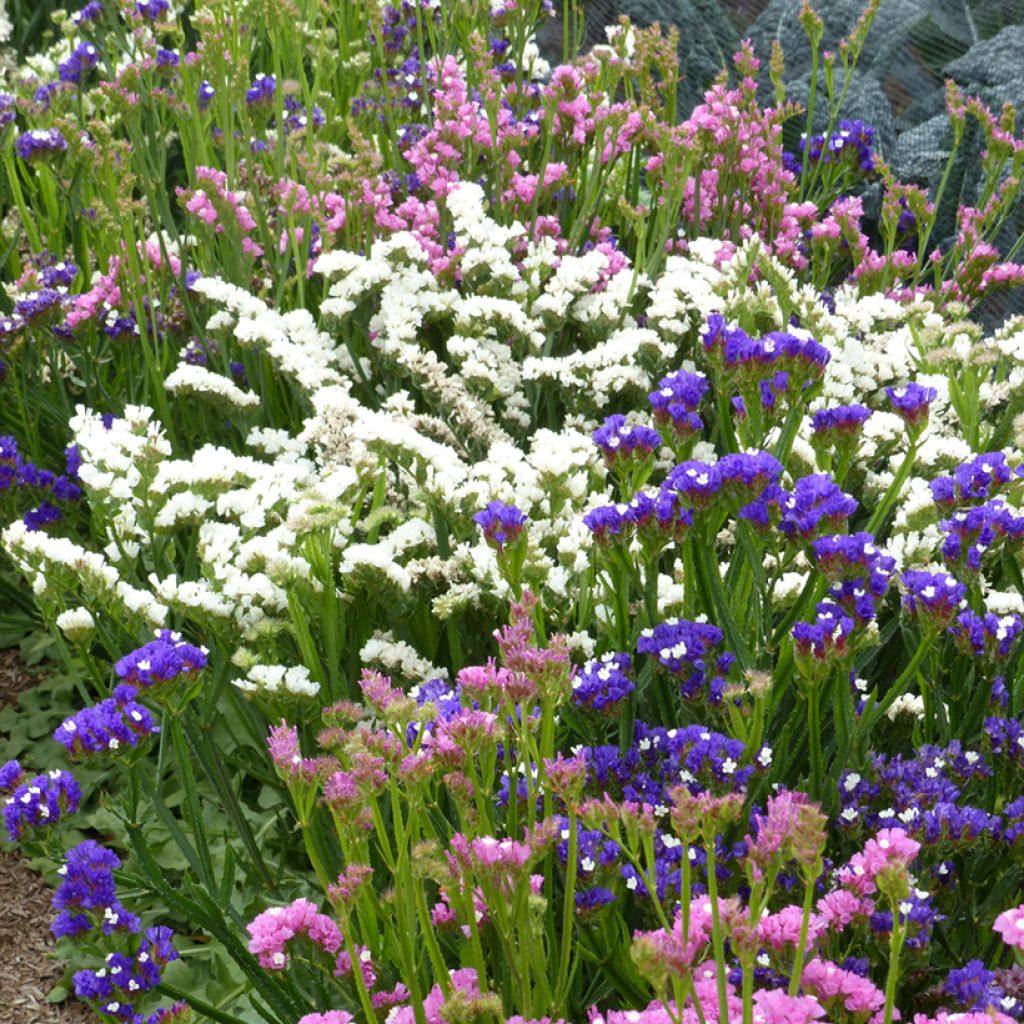

Limonium sinuatum Forever Art Shades seeds - Statice
Limonium sinuatum Forever Art Shades seeds - Statice
Limonium sinuatum Forever Art Shades (Forever series)
wavyleaf sea lavender, Statice
This plant carries a 6 months recovery warranty
More information
We guarantee the quality of our plants for a full growing cycle, and will replace at our expense any plant that fails to recover under normal climatic and planting conditions.
From €5.90 for pickup delivery and €6.90 for home delivery
Express home delivery from €8.90.
Does this plant fit my garden?
Set up your Plantfit profile →
Description
Limonium sinuatum 'Forever Art Shades', also known as Statice or sea lavender, is a tender perennial plant that is grown as an annual for its colourful flowers that last a long time once dried, perfect for creating long-lasting bouquets. This tender plant decorates borders and can also be grown in pots to adorn the terrace. Plants from the 'Forever Art Shades' selection produce large panicles of white, pink, or purple flowers. Statice thrives in the sun in well-drained, light soil, not too dry in summer.
Statice ‘Forever Art Shades’ belongs to the Plumbaginaceae family. Native to Mediterranean coasts, the species (Limonium sinuatum) tolerates the salty and dry soil conditions typical of its natural environment. It has given rise to many horticultural selections with a wide range of colours.
Each plant first forms a basal rosette of lobed and elongated leaves, measuring between 10 and 25 cm, slightly fuzzy. Its stiff, winged stems, reaching 50 to 70 cm in height, bear clusters of small funnel-shaped flowers, with colourful calyces and a paper-like texture. The flower itself is much smaller, almost invisible. The 'Forever Art Shades' flowers come in a palette of white, pink, purple, bluish-purple. They flower from June to September. The flowering is nectar-rich. The fruit is a capsule containing a single seed. This plant readily self-seeds in light soil.
Sea lavender is undoubtedly one of the easiest flowers to dry, simply cut the longest stems possible and hang them upside down in a cool, dry, airy place. They retain their colours for a long time, softening slightly. 'Forever Art Shades' is also useful for lightening up bigger blooms (roses, peonies...), in borders as well as in vases. Sea lavenders can be associated with globe thistles (Echinops ritro) and Pennisetum x advena 'Rubrum', a beautiful annual grass with purple foliage.
Report an error about the product description
Limonium sinuatum Forever Art Shades seeds - Statice in pictures


Flowering
Foliage
Plant habit
Botanical data
Limonium
sinuatum
Forever Art Shades (Forever series)
Plumbaginaceae
wavyleaf sea lavender, Statice
Cultivar or hybrid
Other Statice Seeds - Sea Lavender
Planting and care
Sow the seeds of 'Forever Art Shades' statice in February/March in a greenhouse, propagator or heated room, at home, on the surface of good soil and cover with vermiculite or a thin layer of soil. Germination takes 7 to 14 days at 18-24°C.
Transplant the sufficiently developed young plants into pots, spacing them 5 cm apart, at a slightly lower temperature. Gradually acclimatise them to outdoor conditions for 10-15 days before planting them in the ground, after the last frost, in deep, well-drained soil. Space the plants 30 cm apart.
Statice plants are truly easy to grow. They thrive in the sun, in well-drained, sandy and dry soil. They can withstand salt spray and strong winds, making them perfect candidates for coastal gardens. Planting in spring, on warmed soil. Once in place, simply remove faded flowers to encourage new blooms. At the end of the season, if you wish to try to keep the statice, cut back the stems.
Like many Mediterranean plants, statice is highly drought-resistant but needs water to bloom well in summer. In its native region, it blooms before the onset of summer drought. This plant does not tolerate humidity, which makes it susceptible to Botrytis, grey mould.
Sowing period
Intended location
This item has not been reviewed yet - be the first to leave a review about it.
Flower seeds
Haven't found what you were looking for?
Hardiness is the lowest winter temperature a plant can endure without suffering serious damage or even dying. However, hardiness is affected by location (a sheltered area, such as a patio), protection (winter cover) and soil type (hardiness is improved by well-drained soil).

Photo Sharing Terms & Conditions
In order to encourage gardeners to interact and share their experiences, Promesse de fleurs offers various media enabling content to be uploaded onto its Site - in particular via the ‘Photo sharing’ module.
The User agrees to refrain from:
- Posting any content that is illegal, prejudicial, insulting, racist, inciteful to hatred, revisionist, contrary to public decency, that infringes on privacy or on the privacy rights of third parties, in particular the publicity rights of persons and goods, intellectual property rights, or the right to privacy.
- Submitting content on behalf of a third party;
- Impersonate the identity of a third party and/or publish any personal information about a third party;
In general, the User undertakes to refrain from any unethical behaviour.
All Content (in particular text, comments, files, images, photos, videos, creative works, etc.), which may be subject to property or intellectual property rights, image or other private rights, shall remain the property of the User, subject to the limited rights granted by the terms of the licence granted by Promesse de fleurs as stated below. Users are at liberty to publish or not to publish such Content on the Site, notably via the ‘Photo Sharing’ facility, and accept that this Content shall be made public and freely accessible, notably on the Internet.
Users further acknowledge, undertake to have ,and guarantee that they hold all necessary rights and permissions to publish such material on the Site, in particular with regard to the legislation in force pertaining to any privacy, property, intellectual property, image, or contractual rights, or rights of any other nature. By publishing such Content on the Site, Users acknowledge accepting full liability as publishers of the Content within the meaning of the law, and grant Promesse de fleurs, free of charge, an inclusive, worldwide licence for the said Content for the entire duration of its publication, including all reproduction, representation, up/downloading, displaying, performing, transmission, and storage rights.
Users also grant permission for their name to be linked to the Content and accept that this link may not always be made available.
By engaging in posting material, Users consent to their Content becoming automatically accessible on the Internet, in particular on other sites and/or blogs and/or web pages of the Promesse de fleurs site, including in particular social pages and the Promesse de fleurs catalogue.
Users may secure the removal of entrusted content free of charge by issuing a simple request via our contact form.
The flowering period indicated on our website applies to countries and regions located in USDA zone 8 (France, the United Kingdom, Ireland, the Netherlands, etc.)
It will vary according to where you live:
- In zones 9 to 10 (Italy, Spain, Greece, etc.), flowering will occur about 2 to 4 weeks earlier.
- In zones 6 to 7 (Germany, Poland, Slovenia, and lower mountainous regions), flowering will be delayed by 2 to 3 weeks.
- In zone 5 (Central Europe, Scandinavia), blooming will be delayed by 3 to 5 weeks.
In temperate climates, pruning of spring-flowering shrubs (forsythia, spireas, etc.) should be done just after flowering.
Pruning of summer-flowering shrubs (Indian Lilac, Perovskia, etc.) can be done in winter or spring.
In cold regions as well as with frost-sensitive plants, avoid pruning too early when severe frosts may still occur.
The planting period indicated on our website applies to countries and regions located in USDA zone 8 (France, United Kingdom, Ireland, Netherlands).
It will vary according to where you live:
- In Mediterranean zones (Marseille, Madrid, Milan, etc.), autumn and winter are the best planting periods.
- In continental zones (Strasbourg, Munich, Vienna, etc.), delay planting by 2 to 3 weeks in spring and bring it forward by 2 to 4 weeks in autumn.
- In mountainous regions (the Alps, Pyrenees, Carpathians, etc.), it is best to plant in late spring (May-June) or late summer (August-September).
The harvesting period indicated on our website applies to countries and regions in USDA zone 8 (France, England, Ireland, the Netherlands).
In colder areas (Scandinavia, Poland, Austria...) fruit and vegetable harvests are likely to be delayed by 3-4 weeks.
In warmer areas (Italy, Spain, Greece, etc.), harvesting will probably take place earlier, depending on weather conditions.
The sowing periods indicated on our website apply to countries and regions within USDA Zone 8 (France, UK, Ireland, Netherlands).
In colder areas (Scandinavia, Poland, Austria...), delay any outdoor sowing by 3-4 weeks, or sow under glass.
In warmer climes (Italy, Spain, Greece, etc.), bring outdoor sowing forward by a few weeks.

































